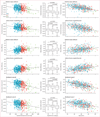Effects of systolic blood pressure on white-matter integrity in young adults in the Framingham Heart Study: a cross-sectional study
- PMID: 23122892
- PMCID: PMC3510663
- DOI: 10.1016/S1474-4422(12)70241-7
Effects of systolic blood pressure on white-matter integrity in young adults in the Framingham Heart Study: a cross-sectional study
Abstract
Background: Previous studies have identified effects of age and vascular risk factors on brain injury in elderly individuals. We aimed to establish whether the effects of high blood pressure in the brain are evident as early as the fifth decade of life.
Methods: In an investigation of the third generation of the Framingham Heart Study, we approached all participants in 2009 to ask whether they would be willing to undergo MRI. Consenting patients underwent clinical assessment and cerebral MRI that included T1-weighted and diffusion tensor imaging to obtain estimates of fractional anisotropy, mean diffusivity, and grey-matter volumes. All images were coregistered to a common minimum deformation template for voxel-based linear regressions relating fractional anisotropy, mean diffusivity, and grey-matter volumes to age and systolic blood pressure, with adjustment for potential confounders.
Findings: 579 (14·1%) of 4095 participants in the third-generation cohort (mean age 39·2 years, SD 8·4) underwent brain MRI between June, 2009 and June, 2010. Age was associated with decreased fractional anisotropy and increased mean diffusivity in almost all cerebral white-matter voxels. Age was also independently associated with reduced grey-matter volumes. Increased systolic blood pressure was linearly associated with decreased regional fractional anisotropy and increased mean diffusivity, especially in the anterior corpus callosum, the inferior fronto-occipital fasciculi, and the fibres that project from the thalamus to the superior frontal gyrus. It was also strongly associated with reduced grey-matter volumes, particularly in Brodmann's area 48 on the medial surface of the temporal lobe and Brodmann's area 21 of the middle temporal gyrus.
Interpretation: Our results suggest that subtle vascular brain injury develops insidiously during life, with discernible effects even in young adults. These findings emphasise the need for early and optimum control of blood pressure.
Funding: National Institutes of Health and National Heart, Lung, and Blood Institute; National Institute on Aging; and National Institute of Neurological Disorders and Stroke.
Copyright © 2012 Elsevier Ltd. All rights reserved.
Conflict of interest statement
We declare that we have no conflicts of interest.
Figures





Comment in
-
Brain injury as end-organ damage in hypertension.Lancet Neurol. 2012 Dec;11(12):1015-7. doi: 10.1016/S1474-4422(12)70265-X. Epub 2012 Nov 2. Lancet Neurol. 2012. PMID: 23122891 No abstract available.
References
-
- Chobanian AV, Bakris GL, Black HR, et al. The seventh report of the Joint National Committee on Prevention, Detection, Evaluation, and Treatment of High Blood Pressure: the JNC 7 report. JAMA. 2003;289:2560–2572. - PubMed
-
- Franklin SS, Gustin Wt, Wong ND, et al. Hemodynamic patterns of age-related changes in blood pressure: the Framingham Heart Study. Circulation. 1997;96:308–315. - PubMed
-
- Vasan RS, Beiser A, Seshadri S, et al. Residual lifetime risk for developing hypertension in middle-aged women and men: the Framingham Heart Study. JAMA. 2002;287:1003–1010. - PubMed
-
- Salerno JA, Murphy DG, Horwitz B, et al. Brain atrophy in hypertension: a volumetric magnetic resonance imaging study. Hypertension. 1992;20:340–348. - PubMed
-
- Swan GE, DeCarli C, Miller BL, et al. Association of midlife blood pressure to late-life cognitive decline and brain morphology. Neurology. 1998;51:986–993. - PubMed
Publication types
MeSH terms
Grants and funding
- R01 NS017950/NS/NINDS NIH HHS/United States
- R01 AG016495/AG/NIA NIH HHS/United States
- N01 HC025195/HC/NHLBI NIH HHS/United States
- AG08122/AG/NIA NIH HHS/United States
- R01 AG008122/AG/NIA NIH HHS/United States
- P30-AG10129/AG/NIA NIH HHS/United States
- R01-NS17950/NS/NINDS NIH HHS/United States
- K01 AG030514/AG/NIA NIH HHS/United States
- N01-HC-25195/HC/NHLBI NIH HHS/United States
- R01 AG033040/AG/NIA NIH HHS/United States
- AG030514/AG/NIA NIH HHS/United States
- AG16495/AG/NIA NIH HHS/United States
- P30 AG010129/AG/NIA NIH HHS/United States
LinkOut - more resources
Full Text Sources
Medical

